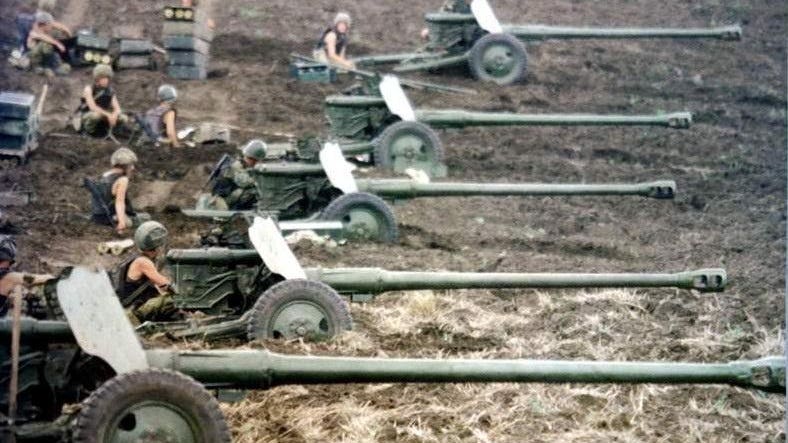In the nearly four months since Ukrainian forces launched their long-anticipated counteroffensive along several axes in southern and eastern Ukraine, the Ukrainians have knocked out no fewer than 80 Russian howitzers and rocket-launchers. The Russians meanwhile have knocked out just 24 Ukrainian howitzers and launchers.
While Russian forces with their 4,000 pre-war artillery systems—more than twice the Ukrainian inventory—have more artillery to lose, the disparity still is stark. And the trend, for the Russians, is ominous.
At the same, escalating Russian losses in howitzers and launchers help to explain why, more and more, the Russians are relying on older artillery. It’s not for no reason that, in recent days, one Ukrainian operator of a first-person-view drone came across—and destroyed—a nearly 80-year-old Russian field gun.
Famous Ukrainian drone operator Robert Brovdi posted the video from the explosive-laden FVP drone as it zoomed toward the D-44, a so-called “divisional gun” that entered Soviet service in 1946.
This isn’t the first time an 85-millimeter D-44 has showed up in the Ukraine war. Ukrainian technicians even have fitted the antique gun to 1970s-vintage MT-LB armored tractors to produce a new kind of tank-destroyer: an MT-LB-44.
But the presence of the aged field gun on the Russian side is a reminder that Russia is losing a lot of artillery, and is scrambling to make good those losses.
The Soviet Union’s Uralmash factory produced more than a thousand D-44s every year between 1945 and 1953. The gun saw widespread use across the Warsaw Pact and allied countries until the more powerful D-30 began replacing it in the early 1980s.
With lower elevation than a howitzer and less armor-penetration than a D-30 is capable of, the old D-44 wasn’t worth all that much until Russia widened its war on Ukraine starting in February 2022.
It was obvious why the Ukrainians would pull D-44s out of long-term storage. At the wider war’s outset, Russia’s howitzers and launchers outnumbered Ukraine’s nearly three to one—and Ukraine had yet to receive from its NATO allies the 1,100 modern artillery systems that have transformed the Ukrainian artillery corps.
But it took a while for steady losses to bite into Russia’s bigger artillery arsenal—and compel the Kremlin to reactive at least a few 1940s-vintage guns. As the wider war grinds toward its third year, the Russians have lost more than a thousand howitzers and launchers; the Ukrainians have lost fewer than 500.
Arty Green, a high-ranking Ukrainian artillery officer, explained the artillery gap that increasingly favors Ukraine. “Precision shells—it’s something the Russian army has no answer against,” he said, referring to American-made Excalibur 155-millimeter shells and other laser- and GPS-guided munitions.
Cued by drones, Ukraine’s Western-made artillery fires farther and more accurately than Russia’s artillery does, allowing Ukrainian gunners to fire at Russian gunners before the Russians even know they’re in the crosshairs. “It’s mostly work at longer ranges with precision weapons,” Arty Green said. “If we detect enemy artillery, we select the most appropriate fire system and strike it.”
At the same time, Art Green said, Ukrainian cruise-missile strikes on Russian convoys and depots are destroying so much artillery ammunition that Russian batteries sometimes run out of shells—this despite Russia’s greater capacity to manufacture ammo.
Knocking out one ancient Russian D-44 field gun doesn’t do much to alter the overall artillery balance of power. But it is a powerful symbol of the Russians’ desperation as more and more of their modern artillery falls victim to Ukrainian barrages. One counterbattery strike at a time, Ukraine slowly is winning the artillery battle.
Read the full article here





